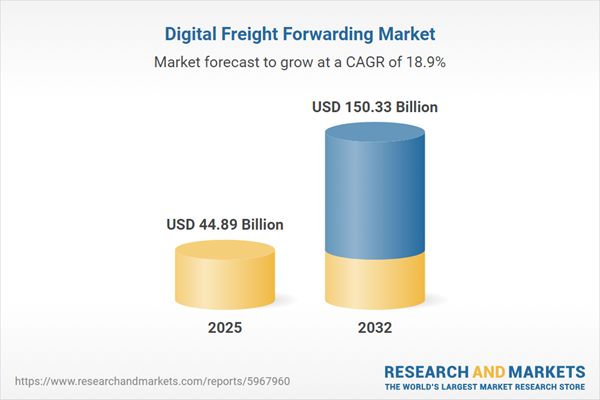Speak directly to the analyst to clarify any post sales queries you may have.
The digital freight forwarding market is redefining logistics operations worldwide by equipping senior leadership with the tools and insights needed for efficient, resilient supply chain management. Senior decision-makers can leverage digital advancements to streamline shipping processes, respond rapidly to shifts, and ensure compliance within complex global trade environments.
Market Snapshot: Digital Freight Forwarding Market Size and Growth
The digital freight forwarding market is experiencing fast-paced growth, with projections showing an increase from USD 37.69 billion in 2024 to USD 44.89 billion by 2025 and a further rise to USD 150.33 billion by 2032. This expansion reflects an impressive CAGR of 18.87%. Industry momentum stems from broad-based adoption of automated, cloud-enabled freight solutions. These technologies boost network connectivity, improve customs and booking management, and provide real-time visibility for smarter logistics decisions. Companies are capitalizing on these capabilities to enhance responsiveness and boost supply chain reliability amid ongoing volatility and evolving market needs.
Scope & Segmentation: Strategic Components of the Digital Freight Forwarding Market
- Service Types: Air freight delivers fast, secure options for time-sensitive cargo, while multimodal, ocean, rail, and road services offer adaptive routing to meet specialized shipment profiles across industries.
- End Use Industries: Aerospace, defense, automotive, manufacturing, pharmaceutical, retail, and consumer electronics use digital platforms to meet compliance demands, track valuable shipments, and maintain operational continuity within global supply chains.
- Shipment Type: Full and partial container load shipments, in addition to consolidated cargo, address a range of freight volumes and optimize space for cost-effective transport.
- Deployment Models: Cloud-based logistics tools support agile scaling and remote management, while on-premise infrastructures meet the needs of sectors with high security or local regulatory requirements.
- Direction: Solutions with integrated real-time tracking empower logistics teams to manage both imports and exports, allowing prompt response to shifting markets and compliance landscapes.
- Regional Coverage: The market serves the Americas, Europe, Middle East and Africa, and Asia-Pacific. Leadership in hubs like the United States, Germany, Brazil, China, and Singapore is driving digital transformation, while variations in regulation and infrastructure shape innovation and adoption rates.
- Technologies: Artificial intelligence enables predictive analytics and operational planning, IoT sensors deliver cargo visibility, blockchain maintains data integrity in logistics records, and cloud computing accelerates solution deployments across expanding business footprints.
- Notable Companies: Leading providers such as Flexport, Freightos Limited, Forto GmbH, Sennder GmbH, Zencargo, InstaFreight, Twill ApS, Saloodo! GmbH, Shipa Freight, and iContainers International influence digital best practices and set industry benchmarks.
Key Takeaways: Strategic Insights for Senior Decision-Makers
- Integrated digital solutions automate logistics workflows, supporting the modernization of supply chain operations and enhancing reliability at every stage.
- Advanced visibility tools empower organizations to anticipate potential disruptions, quickly adjust to dynamic regulations, and protect business continuity in unpredictable global environments.
- Unified digital ecosystems foster transparency and alignment between internal teams and partners, improving response times and facilitating adaptation to changing requirements.
- Cloud-driven models enable seamless regional expansion, facilitate compliance, and help institutions manage risk as operations diversify internationally.
- Tailored digital capabilities, such as real-time monitoring for sensitive goods or expedited booking for retail, uphold sector-specific standards and ensure consistent quality across shipments.
- Automating compliance tasks reduces administrative workloads, limits regulatory risk exposure, and strengthens governance for enterprise resilience.
Tariff Impact: Adapting to US 2025 Tariff Policy Changes
US tariff policy updates in 2025 will require logistics leaders to reevaluate cost structures and planning cycles. By adopting advanced pricing engines and compliance automation, teams gain immediate access to actionable insights, supporting informed decisions and minimizing service interruptions. Automation enables smooth management of operational shifts and helps organizations stay resilient despite changing policy frameworks.
Methodology & Data Sources
This analysis draws from direct interviews with logistics leaders, expert input from technology professionals, and proprietary shipment analytics. Trusted secondary research validates findings, ensuring insights are relevant and actionable for digital transformation in freight forwarding and logistics management.
Why This Report Matters for Digital Freight Forwarding Strategy
- Delivers actionable benchmarks and market trends to accelerate logistics transformation and foster sustainable supply chain optimization.
- Informs decisions around technology investment and compliance strategy, ensuring organizations can adapt quickly to advances in regulation and global trade.
- Equips enterprises to build more resilient and adaptive supply chains, supporting both long-term business objectives and rapid responses to market changes.
Conclusion
Applying these insights enables organizations to modernize logistics processes, strengthen supply chain agility, and build operational excellence in a rapidly digitizing global marketplace.
Additional Product Information:
- Purchase of this report includes 1 year online access with quarterly updates.
- This report can be updated on request. Please contact our Customer Experience team using the Ask a Question widget on our website.
Table of Contents
3. Executive Summary
4. Market Overview
7. Cumulative Impact of Artificial Intelligence 2025
Companies Mentioned
The companies profiled in this Digital Freight Forwarding market report include:- Flexport, Inc.
- Freightos Limited
- Forto GmbH
- Sennder GmbH
- Zencargo Ltd.
- InstaFreight GmbH
- Twill ApS
- Saloodo! GmbH
- Shipa Freight
- iContainers International SL
Table Information
| Report Attribute | Details |
|---|---|
| No. of Pages | 192 |
| Published | November 2025 |
| Forecast Period | 2025 - 2032 |
| Estimated Market Value ( USD | $ 44.89 Billion |
| Forecasted Market Value ( USD | $ 150.33 Billion |
| Compound Annual Growth Rate | 18.8% |
| Regions Covered | Global |
| No. of Companies Mentioned | 11 |









